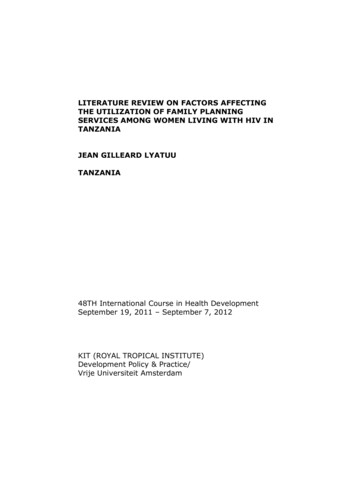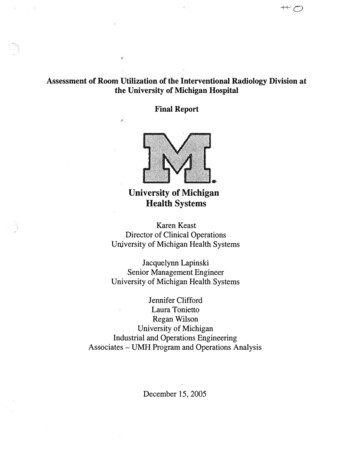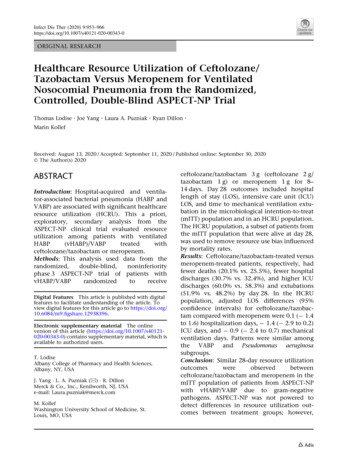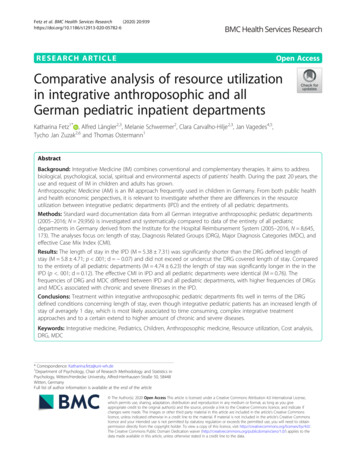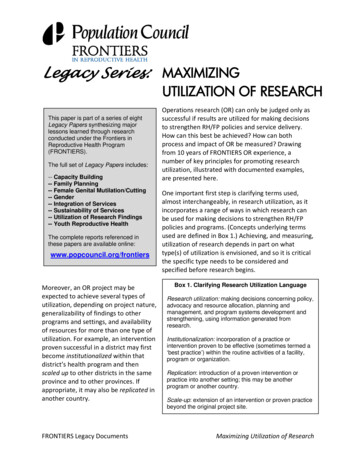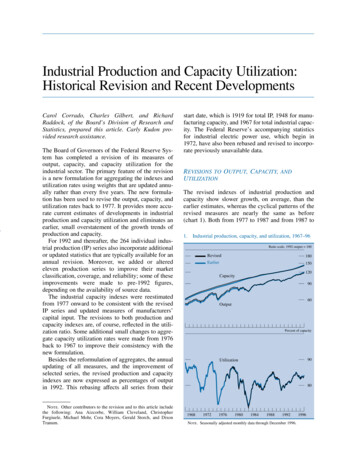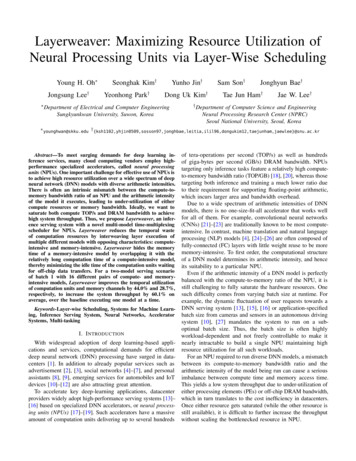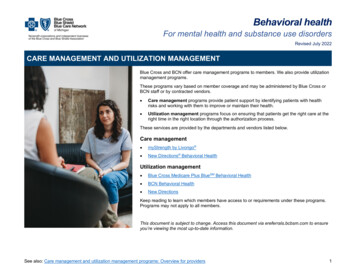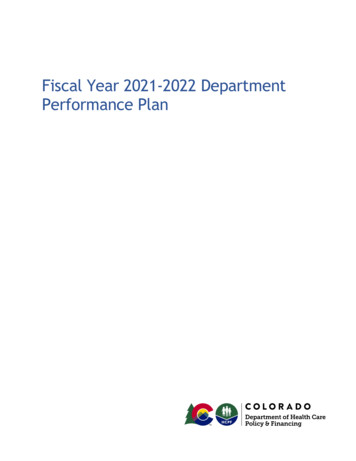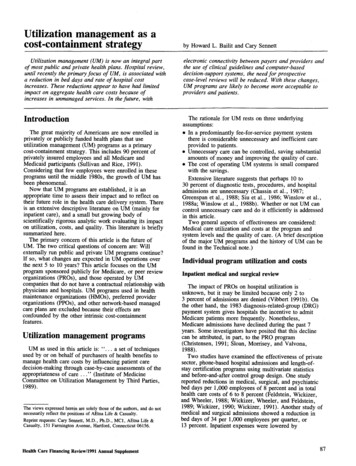
Transcription
Utilization management as acost-containment strategyby Howard L. Bailit and Cary SennettUtilization management (UM) is now an integral partof most public and private health plans. Hospital review,until recently the primary focus of UM, is associated witha reduction in bed days and rate of hospital costincreases. These reductions appear to have had limitedimpact on aggregate health care costs because ofincreases in unmanaged services. In the future, withelectronic connectivity between payers and providers andthe use of clinical guidelines and computer-baseddecision-support systems, the need for prospectivecase-level reviews will be reduced. With these changes,UM programs are likely to become more acceptable toproviders and patients.IntroductionThe rationale for UM rests on three underlyingassumptions: In a predominantly fee-for-service payment systemthere is considerable unnecessary and inefficient careprovided to patients. Unnecessary care can be controlled, saving substantialamounts of money and improving the quality of care. The cost of operating UM systems is small comparedwith the savings.Extensive literature suggests that perhaps 10 to30 percent of diagnostic tests, procedures, and hospitaladmissions are unnecessary (Chassin et al., 1987;Greenspan et al., 1988; Siu et al., 1986; Winslow et al.,1988a; Winslow et al., 1988b). Whether or not UM cancontrol unnecessary care and do it efficiently is addressedin this article.Two general aspects of effectiveness are considered:Medical care utilization and costs at the program andsystem levels and the quality of care. (A brief descriptionof the major UM programs and the history of UM can befound in the Technical note.)The great majority of Americans are now enrolled inprivately or publicly funded health plans that useutilization management (UM) programs as a primarycost-containment strategy. This includes 90 percent ofprivately insured employees and all Medicare andMedicaid participants (Sullivan and Rice, 1991).Considering that few employees were enrolled in theseprograms until the middle 1980s, the growth of UM hasbeen phenomenal.Now that UM programs are established, it is anappropriate time to assess their impact and to reflect ontheir future role in the health care delivery system. Thereis an extensive descriptive literature on UM (mainly forinpatient care), and a small but growing body ofscientifically rigorous analytic work evaluating its impacton utilization, costs, and quality. This literature is brieflysummarized here.The primary concern of this article is the future ofUM. The two critical questions of concern are: Willexternally run public and private UM programs continue?If so, what changes are expected in UM operations overthe next 5 to 10 years? This article focuses on the UMprogram sponsored publicly for Medicare, or peer revieworganizations (PROs), and those operated by UMcompanies that do not have a contractual relationship withphysicians and hospitals. UM programs used in healthmaintenance organizations (HMOs), preferred providerorganizations (PPOs), and other network-based managedcare plans are excluded because their effects areconfounded by the other intrinsic cost-containmentfeatures.Utilization management programsUM as used in this article is: " . a set of techniquesused by or on behalf of purchasers of health benefits tomanage health care costs by influencing patient caredecision-making through case-by-case assessments of theappropriateness of care . " (Institute of MedicineCommittee on Utilization Management by Third Parties,1989).The views expressed herein are solely those of the authors, and do notnecessarily reflect the positions of AEtna Life & Casualty.Reprint requests: Cary Sennett, M.D., Ph.D., MCI, AEtna Life &Casualty, lSI Farmington Avenue, Hartford, Connecticut 06156.Health Care Financing Review/1991 Annual SupplementIndividual program utilization and costsInpatient medical and surgical reviewThe impact of PROs on hospital utilization isunknown, but it may be limited because only 2 to3 percent of admissions are denied (Vibbert 1991b). Onthe other hand, the 1983 diagnosis-related-group (DRG)payment system gives hospitals the incentive to admitMedicare patients more frequently. Nonetheless,Medicare admissions have declined during the past 7years. Some investigators have posited that this declinecan be attributed, in part, to the PRO program(Christensen, 1991; Sloan, Morrisey, and Valvona,1988).Two studies have examined the effectiveness of privatesector, phone-based hospital admissions and length-of stay certification programs using multivariate statisticsand before-and-after control group design. One studyreported reductions in medical, surgical, and psychiatricbed days per 1,000 employees of 8 percent and in totalhealth care costs of 6 to 8 percent (Feldstein, Wickizer,and Wheeler, 1988; Wickizer, Wheeler, and Feldstein,1989; Wickizer, 1990; Wickizer, 1991). Another study ofmedical and surgical admissions showed a reduction inbed days of 34 per 1,000 employees per quarter, or13 percent. Inpatient expenses were lowered by87
8 percent, and total health care costs by 4.5 percent(Khandker and Manning, 1992).Compared with telephone-based hospital review,reductions of another 6 percent in bed days per1,000 employees and 9 percent in net costs are reportedwhen the need for hospital admissions and continued stayis reviewed onsite (in the hospital) by nurses (Smith andGotowka, 1991).Psychiatric and substance abuseBecause Medicare has limited mental health coverage,PROs have little involvement in managing psychiatric andsubstance abuse utilization. For private sector, telephone based UM programs, the one published multivariate studyfound reductions in length of stay of 20 percent, inadmission rates of 13 percent, and in net inpatient costsof 16.6 percent (Gotowka and Smith, 1991).Medical and surgical proceduresUntil recently, PROs prospectively reviewed up to10 surgical procedures using explicit criteria. There islittle information available on the impact of thesereviews, but because they have been discontinued, it isapparent that they were not considered to be effective.Many studies in the private sector have assessed theeffects of second surgery opinion systems, and the resultsare mixed (Leape, 1989). The weight of the evidencesuggests that these programs are only marginally effectivein controlling costs.The use of clinical protocols to prospectively assess theneed for selected tests and surgical procedures is justgetting started. Denial rates appear to be substantial forsome services, e.g., hysterectomies, 21.5 percent,tonsillectomies, 27.1 percent, and minimal for others,e.g., cardiac bypass surgery (Vibbert, 1991a). The denialrate across all inpatient and outpatient services averaged11 percent. No data are available on net program savings.Case managementThe one study of case management programs reportednegligible short-term net savings (Henderson, Souder, andBergman, 1988). Because of the paucity of studies andthe complexities of evaluating case managementprograms, any conclusions would be premature.System level trendsAt the delivery system level, hospital precertificationsystems are considered to be an important factor in thedramatic reduction (18.6 percent) in the use ofcommunity hospital bed days from 1981 to 1988. Thisreduction in bed utilization is associated with a substantialreduction in the rate of hospital cost increases (Schwartzand Mendelson, 1991). However, these hospital UMprograms appear to have had only a modest impact ontotal health care cost increases (Schwartz and Mendelson,1991; Chulis, 1991). Apparently, providers responded tolower bed occupancy rates by increasing utilization ofoutpatient tests and procedures and inpatient andoutpatient fees.88QualityThe effect of UM on the quality of care has generateda great deal of speculation but little serious study. Adefinitive series of investigations has been done on theimpact of Medicare's prospective payment system (PPS)on mortality and morbidity. The specific effects of PROson quality were not examined separately. Most otherwork in this area concerns provider, patient, andemployer satisfaction with UM systems.PPS and PROs started about the same time. Anexamination of their combined impact on quality providessome insights on the effect of UM programs. Focusing onfive conditions (acute myocardial infarction, pneumonia,congestive heart failure, cerebrovascular accidents, andhip fracture), a comparison of mortality and morbidityrates before and after the introduction of the (PPS1981-82 and 1985-86 respectively) showed that PPS wasassociated with: an improvement in the process of care(Rubenstein et al., 1990); an increase in the percent ofpatients discharged in an unstable condition (Kosecoffet al., 1990); and no differences in 30-day and 180-daypost-admission mortality rates (Kahn et al., 1990). Thesedata suggest that PPS and PROs have not led to areduction in the quality of care. Little is known about theimpact of private sector UM programs on quality.Another dimension of quality is provider, patient, andemployer satisfaction with UM. There is considerableprovider dissatisfaction with UM programs. Most concernis with the "hassle factor" associated with previouslyautonomous physicians having to justify admissions,length of stay, and procedures to UM companies over thephone, dealing with review staff who have varying levelsof training and expertise and do not know the patient, andtrying to comply with multiple sets of proprietary clinicalrules (Grumet, 1989; Stevens, 1990). These problems areexacerbated by the additional operating expensesassociated with UM (Holthaus, 1989; Mayo Clinic,1988).On the other hand, it is clear that most physicians andhospitals have acquiesced to UM and do comply withUM processes. The key provider concern now appears tobe the need to standardize and improve UM systems andoperations (Institute of Medicine Committee onUtilization Management by Third Parties, 1989).Patients and employersInformation on patient satisfaction with UM programsis very limited. Reports by UM companies suggest thatpatients are generally satisfied (Institute of MedicineCommittee on Utilization Management by Third Parties,1989).In general, employers' response to UM have beenpositive, with 73 percent supporting the reviewing ofdoctors' treatment decisions as a cost control strategy(Health Insurance Association of America, 1991).However, a recent survey by A. Foster Higgins (1990)suggests that employers have some skepticism about theeffect of UM: A large percentage report that they don'tknow if UM programs are effective in controlling costs.Health Care Financing Review/1991 Annual Supplement
Future of utilization managementAssessing valueFrom this review of the literature and from the authors'personal experience operating UM and managed caresystems, two questions are addressed: Will payer operatedUM continue? If so, what changes are likely to occur inUM programs over the next 5 to 10 years?There are two reasons to believe that publicly andprivately operated UM programs will continue. UM canmake a significant contribution both to managing healthcare costs and to assessing the value of health services inimproving health.Another reason that UM is likely to continue relates tothe rising demand for accountability and value. Withlarge and growing expenditures for health care, payerswant to know how their money is spent and what itproduces in terms of health care quality (process andoutcomes).This is in part the result of growing public awarenessof how little is known about the effects of medicalprocedures and tests on health outcomes, and thesignificant and unexplained variation in practice patternsamong geographic regions and individual physicians.There appears to be greater appreciation that the linkagebetween utilization of service and health outcomes is verycomplex, and that more services do not necessarily meanbetter health.The point is that the need for UM goes beyond theissue of controlling costs. UM is a primary approach thatpublic and private payers can use to determine if patientsare receiving appropriate care and if the money spent onhealth care is providing value. With this information,payers are in a better position to make informed decisionsabout health plan and delivery system changes that willlead to greater value.In summary, there are good reasons to believe that UMwill continue. Indeed, UM systems of the general typeused in the United States may eventually be adopted byother countries that have controlled health care coststhrough global budgeting but have little information onthe value of the services purchased (Anderson, Sheps,and Cardiff, 1990; Hurst, 1991).Managing costsAlthough the number of scientifically rigorous studiesis limited, the available literature indicates that hospitaladmissions and length-of-stay precertification programs,both medical and surgical, and psychiatric and substanceabuse, have led to significant reductions in bed days per1,000 employees. The data from individual studies aresupported by additional evidence from national trends inhospital admissions and length of stay. Clearly, UMsystems are associated with major changes in practicebehavior.As to their effect on costs at the individual plan level,a few well-controlled studies of hospital review programsreport net total health care savings of 4.5 to 8 percent(Feldstein et al., 1988; Gotowka and Smith, 1991;Khandker and Manning, to be published; Smith andGotowka, 1991; Wickizer, et al., 1989). Likewise at thesystem level, UM programs are associated with asignificant reduction in the rate of increase in hospitalcosts during the 1980s (Schwartz and Mendelson, 1991).In terms of total health care costs, hospital utilizationreview has had less impact. This may be in part a timingeffect, because it is only in the last few years that themajority of employers have had hospital precertification.Another and more important explanation may be thesubstantial increases in utilization for non-reviewedservices, mainly outpatient.To deal with this problem, utilization review is nowbeing extended to the outpatient setting, and in timeshould lead to significant reductions in utilization rates.With all the major medical care services undermanagement, it is far more likely that decreasedutilization rates will be reflected in significant reductionsin the growth of health care costs.This does not mean that UM will be the primarymethod for bringing health care cost increases down tosocially acceptable levels. Rather, it is an importantcomponent of a larger managed care strategy that includescontracting with or employing a select group of providersand having appropriate financial incentives to encouragethem to practice high quality efficient medicine.Further, even with effective managed care, the controlof health care costs will also require public policies todeal with the "macro" level problems of uncheckedgrowth of health care technology, facilities, andmanpower. Increases in consumer cost sharing may alsobe a necessary component of an overall national cost containment policy. Within this context, UM can play asignificant role in improving the efficiency of the deliverysystem.Health Care Financing Review/1991 Annual SupplementUtilization management changesWhat is likely to change in the next 5 to 10 years arethe form and content of UM. Most of these changes willbe driven by new UM technologies and organizationalrelationships. Effective UM is dependent on havingaccess to detailed clinical information on the careproposed or delivered to patients, clinical guidelines thatdefine appropriate care, and positive long-termrelationships with providers.UM programs are severely constrained by the lack ofadequate data to support informed and timely decisionson the appropriateness of care delivered to individualpatients and to cohorts of patients in a practice or region.Moreover, current approaches to collecting data over thetelephone are complex, physician-time intensive, andexpensive. This is certain to change in the next few yearsas providers and payers become linked electronically.This technology is now being installed in hospitals, retailpharmacies, medical laboratories, physician offices, andother delivery settings. Once connected, providers cancheck patient eligibility, transmit claims, and rapidly andefficiently do many UM tasks such as hospitalprecertification, thereby reducing much of theadministrative cost and complexity.With electronic data transmission, patient and providerdata bases can be created that span multiple health careservices (e.g., medical, laboratory, pharmacy) in order toobtain a more comprehensive understanding of theappropriateness of the care delivered to individuals andgroups of patients over time. With adequate data, UM89
systems will be able to identify those specific problemconditions and providers that need review and those thatdo not. By targeting reviews, it will be possible to focuson a relatively small subset of conditions and providers,thereby reducing the cost of UM.A second development is the establishment of explicitclinical guidelines that define appropriate care. Currently,most UM companies use implicit rules (e.g., physicianjudgment) or simple indication lists to guide UM reviews.Brook (1991) suggests that decision-tree type guidelinesare needed for about 200 common conditions thatencompass most of medical practice. Support for thisview is growing, and many professional groups andFederal research agencies are developing explicit clinicalguidelines.Whether there should be one basic set or multiple setsof national guidelines remains an issue. There appears tobe a consensus that guidelines, although based on generalmedical science, have to recognize limitations in localmedical resources. Moreover, the clinical logic used inguidelines must be available to the providers beingreviewed. Finally, guidelines must allow for rapiddecisionmaking, so as not to delay needed care and tomitigate the hassle factor.The requirement for timely UM decisions has limitedthe quality of the UM process to a greater extent than theavailability of guidelines. Timely reviews require eitherthat the guidelines be relatively simple or that they be incomputer systems that can negotiate complex clinicalalogrithms in real-time. For many conditions, the UMprocess will not be very effective using simple rules, sothe key is to build systems that can handle complexdecision rules. With advancements in computer hardwareand decision-support systems, more timely reviews arepossible.In this regard, the development of computerizedmedical record systems is especially promising.Electronic records will have the capacity to includeclinical guidelines in the form of decision-supportsystems. This technology will allow timely clinicaldecisions and will change the focus of UM. The need forprospective case-level reviews will be reduced becauseprovider decisions will be assisted internally. Overallprovider performance can be assessed by retrospectivereview of selected subsets or abstracts of electronicallystored clinical data that would be available to payers,reviewers, and others (Detmer, 1991).It is imperative that managed care companies andproviders establish congruency in their objectives. This isthe only way that UM programs will be successful usingthe advanced information technology and clinicalguidelines described. To date, many providers view UMas an effort to limit their professional autonomy andincome. As a result, attempts to control utilization in onearea of medical care are likely to be countered withincreases in volume and prices in other non-regulatedareas. There is evidence that this has been the case withhospital review systems (Schwartz and Mendelson, 1991).With congruent objectives, UM can be expected toevolve from its current role as a "command and control"regulatory program to more of an educational anddecision-support system for physicians. In this way, UMwill be of greater value to practitioners and patients and,as a result, should gain broader support.90Congruent objectives can be developed in a number ofways including employment of physicians, as seen instaff and group model HMOs and hospitals, or in strongsupplier-customer relationships. Employment ofphysicians is increasing, but the great majority ofphysicians remain self-employed. As such, the challengefacing the managed care industry and providerscommitted to PPOs and individual practice association(IPA)-model HMOs is to develop supplier-customerrelationships that are long-term and stable.More managed care companies appear to appreciatethis perspective and are changing their relationship withnetwork providers. This takes on different formsincluding: decentralizing managed care operations to localmarkets in order to foster personal relations withproviders; selecting providers who practice high quality,efficient care which reduces the need for case-levelreviews; using UM as an educational rather than as apunitive approach to improving performance; and finally,making sure that the relationship is profitable for bothparties.Further, as managed care patients become an increasingpercentage of physicians' practices, providers will have asimilar incentive to develop long-term relationships withthose managed care companies with whom they havecongruent objectives and values. If stable relationshipscannot be developed between independent providers andmanaged care companies, it is unlikely that IPA-modelHMOs will be able to compete successfully over the longrun with staff and group-model HMOs.SummaryIn less than a decade, UM has grown from a narrowlyfocused effort to reduce hospital utilization, affecting onlya fraction of the population, to a large set of programsand services that now cover most of the publicly andprivately insured population. With such rapid growth andbillions spent in development and operations, questionshave been raised about the impact of UM on health carecosts and quality.Although still in a formative stage, the evidenceindicates that hospital review, until recently the primaryfocus of UM efforts, is associated with a significantreduction in bed days and the rate of cost increases atboth the program and system levels. However, thesereductions have, apparently, had limited impact onaggregate health care costs. As hospital bed daysdeclined, the cost of unmanaged medical servicesincreased. Now, UM is being extended beyond hospitalsto include most major medical care services.UM is likely to continue as an important component ofthe national effort to control health care costs and toimprove quality. In part, this is because UM is animportant means for assessing the value of health careservices.In the future, advances in electronic connectivity andthe availability of clinical guidelines and computer-baseddecision-support systems will reduce the need forprospective case level reviews. Also, many managed carecompanies are trying to develop long-term stablerelationships with providers. With these changes, UMprograms are likely to become more cost-effective andacceptable to providers, employers, and patients.Health Care Financing Review/1991 Annual Supplement
AcknowledgmentsWe appreciate the constructive reviews of this articleby Charles Bell, Bradford Gray, Jacqueline Kosecoff,Lois Maiman, Ronald Parton, and Keith Stevenson.Technical noteTwo major attributes that differentiate UM programsare organizational sponsor and time of review relative towhen care is delivered.Review organization sponsorUM programs differ in purpose and method dependingo? whether they are publicly or privately run. Publiclydtrected UM systems are based on legislation and are notsubject to the same legal constraints (e.g., tort liability,antitrust, malpractice) as privately directed systems.Further, in all publicly run systems providers areresponsible for initiating and complying with UMprocesses. Patients are usually held harmless for anypenalties caused by failing to comply with UM or for anyretrospective payment denials. In contrast, for privatesector non-network based UM, patients are theresponsible party.Importantly, for both public and private sectorprograms, denial of certification only means the insurerwill not pay for (all or part of) the services. Although thisdoes not prevent the patient from receiving treatment, itmay act as a significant deterrent for expensive services.Time of reviewProspectiveProspective UM addresses care while it is still beingplanned and, consequently, has the capacity to change oravert planned treatments. Current systems focus primarilyon the inappropriate use of inpatient facilities andexpensive diagnostic tests and procedures.Before an elective hospital admission, either patients orattending physicians call to inform the revieworganization that is often represented by a registerednurse. For non-elective admissions, patients and providersare asked to certify within 48 hours of the admission. Ina discussion with attending physicians or their staff, thereview organization makes an assessment if the conditionis severe enough to warrant hospital level care, and if theexpected length of time the patient will be hospitalizedrepresents efficient medical practice. Explicit condition specific criteria are often used to assist in making thesejudgments.As with most certification programs, if agreement isnot reached, the case is referred to a review physicianwho can deny certification for the admission. Theattending physician and patient have the right to appealthe denial. Failure to certify or to comply with the reviewdecision is usually associated with a financial penalty.Health Care Financing Review/1991 Annual SupplementThere are two forms of procedure certification. Secondopinion surgery programs require or make available topatients a second opinion from another physician for 10to 20 elective surgical procedures before they undergotreatment. In most programs, patients have the option ofproceeding with surgery even if the second physiciandoes not agree with the first.Another approach to procedure certification operates ina similar manner to hospital admissions review. Focusingon the necessity of expensive inpatient and outpatienttests and surgical treatments, clinical protocols (alsocalled guidelines, algorithms, or parameters) are used toassist review staff in making decisions.ConcurrentConcurrent review programs focus on the ongoing careof patients, and thus can intervene to change plannedtreatments. For hospitalized patients, review organizationsmonitor by telephone or by onsite nurses whether patientsneed hospital-level care. Likewise, for patients withcatastrophic (e.g., acquired immunodeficiency syndrome)or chronic (e.g., diabetes) illnesses UM staff work withpatients, families, and attending physicians to assist incoordinating care. Reviewers can obtain payment fornon-covered benefits (e.g., home health care) if they arelikely to result in more effective or efficient care.RetrospectiveThese programs assess care after the fact from recordsand claims and have little potential to directly affect careprovided to patients. Retrospective review can influencepatient care indirectly by changing the practice patterns ofproviders faced with retrospective denials. Recordreviews are employed both as a primary review methodand as a response to post-treatment appeals fromprosp ctive or concurrent reviews. Before being paid,submitted claims are monitored to identify and correctclaim coding abuses such as unbundling and code creep.History of utilization managementProfessional standards review organizations (PSROs)were established in 1972 by the Federal government toprovide UM services to Medicare patients but wereterminated in 1982 because of lack of effectiveness(Health Care Financing Administration, 1980). In 1983,PSROs were replaced by PROs. Federally financed andregulated but regionally operated by local contractors(approximately one per State), PROs are responsible forassuring the quality of services and eliminatingunnecessary care.PROs focus on reviewing high-volume electiveprocedures, hospital admissions, transfers andreadmissions, and DRG "outlier" hospital days. PROsemphasize retrospective review of records but also dosome prospective review of selected procedures. TheOmnibus Budget Reconciliation Act of 1986 expanded RO activities to a variety of non-hospital settings,mcluding ambulatory surgeries, nursing homes, homehealth care agencies, and HMOs (Ermann, 1988).The first privately sponsored UM programs began inthe middle 1960s and focused on hospital utilization.91
They covered very few employees until the middle to late1980s (Ermann, 1988), but now include about 90 percentof the 180 million people with private medical insurance(Sullivan and Rice, 1991). The review of psychiatric andsubstance abuse and dental services is also widespread.UM for other medical services (e.g., laboratory medicine,pharmacy) and settings of care (e.g., physician offices)are just beginning.A new industry has developed in the last 10 years toprovide employers UM services. In addition to the largenational insurers (e.g., Metlife, AEtna, and TheTravelers) and HMO companies (e.g, Humana HealthPlan, Inc., U.S. Health Care, Inc.) that provide a fullspectrum of managed care services, there are about200 companies that only offer UM services (MedicalUtilization Review Directory, 1991). Some of thesecompanies are national in scope (e.g., INTRACORP,HealthCare Compare), but most are regional or local.These companies usually specialize in one area of UM(e.g., medical and surgical or psychiatric and substanceabuse) so that it is not unusual for an employer to havecontracts with several UM companies.There is considerable variation among UM companiesin the types, qualifications, numbers, and location ofreview staff employed, criteria used to assess clinicalappropriatenes
bed days per 1,000 employees of 8 percent and in total health care costs of 6 to 8 percent (Feldstein, Wickizer, and Wheeler, 1988; Wickizer, Wheeler, and Feldstein, 1989; Wickizer, 1990; Wickizer, 1991). Another study of medical and surgical admissions showed a reduction in bed days of 34 per 1,000 employees per quarter, or 13 percent.
